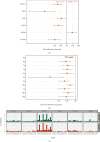Somatic Alteration Characteristics of Early-Onset Gastric Cancer
- PMID: 35498538
- PMCID: PMC9054482
- DOI: 10.1155/2022/1498053
Somatic Alteration Characteristics of Early-Onset Gastric Cancer
Abstract
Gastric cancer is one of the most common and deadly cancer types worldwide, which brings millions of dollars of economic loss each year. Patients diagnosed with early-onset gastric cancer were reported to have a worse prognosis compared to other gastric cancer patients, while the mechanisms behind such phenomenon are unknown. To identify age-dependent somatic alternations in gastric cancer, next-generation sequencing targeting 425 genes was performed on 1688 gastric tumor tissues and corresponding plasma samples. In our study, the microsatellite instability (MSI) and chromosomal instability score (CIS) values increased along with the age of patients, which indicates that older patients display a less genomic stability pattern. The differences of somatic alternations between young and old groups were compared. Somatic mutations CDH1 and copy number gains of FGFR2 were identified to enrich in the younger gastric cancer patients, which may contribute to the worse prognosis of early-onset gastric cancer patients.
Copyright © 2022 Qiyang Zhou et al.
Conflict of interest statement
HLC, HB, XW, and YS are employees of Nanjing Geneseeq Technology, Inc. All other authors declared no conflicts of interest.
Figures





Similar articles
-
Genomic alterations in advanced gastric cancer endoscopic biopsy samples using targeted next-generation sequencing.Am J Cancer Res. 2017 Jul 1;7(7):1540-1553. eCollection 2017. Am J Cancer Res. 2017. PMID: 28744403 Free PMC article.
-
Detection of a novel panel of 24 genes with high frequencies of mutation in gastric cancer based on next-generation sequencing.World J Clin Cases. 2022 May 26;10(15):4761-4775. doi: 10.12998/wjcc.v10.i15.4761. World J Clin Cases. 2022. PMID: 35801059 Free PMC article.
-
Novel Variants and Copy Number Variation in CDH1 Gene in Iranian Patients with Sporadic Diffuse Gastric Cancer.J Gastrointest Cancer. 2019 Sep;50(3):420-427. doi: 10.1007/s12029-018-0082-7. J Gastrointest Cancer. 2019. PMID: 29577179
-
DNA Methylation and Genetic Aberrations in Gastric Cancer.Digestion. 2021;102(1):25-32. doi: 10.1159/000511243. Epub 2020 Oct 16. Digestion. 2021. PMID: 33070127 Review.
-
Microsatellite instability in colorectal cancer.EXCLI J. 2018 Jan 22;17:159-168. doi: 10.17179/excli2017-948. eCollection 2018. EXCLI J. 2018. PMID: 29743854 Free PMC article. Review.
Cited by
-
Bone Metastasis Mediates Poor Prognosis in Early-Onset Gastric Cancer: Insights Into Immune Suppression, Coagulopathy, and Inflammation.Cancer Med. 2025 Mar;14(5):e70737. doi: 10.1002/cam4.70737. Cancer Med. 2025. PMID: 40040540 Free PMC article.
-
The Molecular Landscape of Gastric Cancers for Novel Targeted Therapies from Real-World Genomic Profiling.Target Oncol. 2024 May;19(3):459-471. doi: 10.1007/s11523-024-01052-1. Epub 2024 Apr 13. Target Oncol. 2024. PMID: 38613733
-
Clinical Characteristics and Oncological Outcomes of Surgically Treated Early-Onset Gastric Adenocarcinoma - a Retrospective Cohort Study.J Cancer. 2023 May 21;14(9):1470-1478. doi: 10.7150/jca.82876. eCollection 2023. J Cancer. 2023. PMID: 37325055 Free PMC article.
-
Comprehensive characterization of FBXW7 mutational and clinicopathological profiles in human colorectal cancers.Front Oncol. 2023 Mar 29;13:1154432. doi: 10.3389/fonc.2023.1154432. eCollection 2023. Front Oncol. 2023. PMID: 37064111 Free PMC article.
-
Comprehensive characterization of PKHD1 mutation in human colon cancer.Cancer Med. 2024 Jan;13(1):e6796. doi: 10.1002/cam4.6796. Epub 2024 Jan 4. Cancer Med. 2024. PMID: 38178618 Free PMC article.
References
-
- IARC. Estimated age-standardized incidence rates (world) in 2020, stomach, both sexes, all ages . WHO; 2020.
-
- Charitos I. A., D’Agostino D., Topi S., Bottalico L. 40 years of helicobacter pylori: a revolution in biomedical thought. Gastroenterol. Insights . 2021;12(2):111–135. doi: 10.3390/gastroent12020011. - DOI
LinkOut - more resources
Full Text Sources
Miscellaneous

